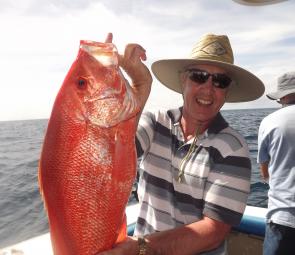This winter, or dry season as we call it in the tropics, is shaping up to be a very good fishing period on quite a few levels. The only deterrent will be the fresh southeasterly trade winds that can, and already have, blown for extended blocks preventing any opportunity for heading offshore.
When the weather has been cherry ripe there has been some very exciting fishing along the coastline and extending out to the extreme edges of the Great Barrier Reef.
As predicted the reef fishing has been in full flight for some time now and results have exceeded most expectations.
Leading the charge has been the large mouth nannygai, or saddle-tail sea perch, brigade that are undoubtedly one of the finest fish to be sourced on the reef. They have been consistently on the bite in the 35-50m depth range across rubbly patches of ground and isolated reef bommies across the open water. Their sizes have been quite varied from your just-legal size to your super-sized models of 8-9kg.
Interestingly the schools of nannygai are of all different sizes, which is not the norm. Often once you source these fish they tend to be of similar size whether it be the 3-5kg range or even the bigger specimens. However for whatever reason they are a mixed bag of sizes this year. Nevertheless, the important thing is there are quality numbers of them up and about.
Besides the nannygai there has been an array of other species caught in prolific numbers at times including coral trout, spangled and red emperor, gold spot trevally, small mouth nannygai, sweetlip, Moses perch and golden trevally.
To add to this there are solid numbers of Spanish mackerel in the area and it is sacrilege not to have a floating pilchard or live bait out the back while at anchor. Quite often the large mouth schools and the Spanish are working the same area where the bait tends to congregate in these open waters and anglers can cash in on both.
The pelagic scene is also into full swing. During the cooler months on calm days with a bit of run in the current the giant trevally fishing can be quite exceptional. For those in the know there are certain reef systems that hold healthy numbers of these fish and by working the pressure edges, where fusiliers and other bait schools accumulate, quality numbers of fish can be plucked out of the ocean using popper lures. A couple of our charter operators are catching between 15-30 GT of all sizes up to 25kg per session, which is solid fishing for any angler. Add to this some trolling for mackerel and what you end up with is an action packed day on the light tackle gear. It is the sort of fishing that is so much in demand these days and outer reef waters are producing very nicely for those prepared to take up the challenge.
On another positive note it seems like our small black marlin season is continuing on from last year’s sensational result with good numbers of ‘beakies’ being registered on our local grounds between Port Douglas and Cairns. We are seeing good numbers of fish around the 25-35kg range as opposed to the 15-20kg models we experienced last year.
For targeting blacks, first travel to the grounds and then source good clean water that is holding solid bait schools of fish. Using a spread of skipping garfish and small pusher skirted lures, troll around these bait schools and you will likely raise a marlin.
When using 10-15kg light tackle gear these fish are just a spectacular fight with their aeronautical jumps and searing runs. Once you’ve caught and released your marlin the challenge then is to try and find the bait fish again. This can be a bit challenging in open water as the bait can quickly move on with the ocean currents. Once you’ve established an idea of where the bait is moving you can easily raise several fish in a short period.
A bit closer to home around the islands and headlands another pelagic terrier has been sourced in good numbers in recent times. The big 1m long talang queenfish have gathered at certain points and have been taking advantage of the healthy supply of bait that they have pocketed into corners. Quite often these bays are close to major land pressure points that attracts bait, and these fish then tend to force them just around the corner and hem them in. By casting poppers and dragging hardbody lures over these patches of water, the queenfish more than often can’t refuse the offer and will hit at a ferocious pace. Their aerodynamic capabilities are also legendary and they also possess plenty of juice on the searing runs.
As you can gather there is some really exciting fishing going on the bluewater scene at the moment but you need those really calm weather days to take the full advantage. If the weather isn’t behaving, our local rivers and creeks are offering some good fishing on grunter, golden trevally, big fat bream and mid-sized queenfish and giant trevally. That’s your back up plan, but I’d be looking to head offshore at every chance.
Reads: 1468
Nannygai have been consistent and there are some cracking fish amongst the schools that will test angler skill and their gear to the limit.

GT are a great sportfish that are smacking lures and baits right now. Trips of 15-20 fish are not uncommon.




